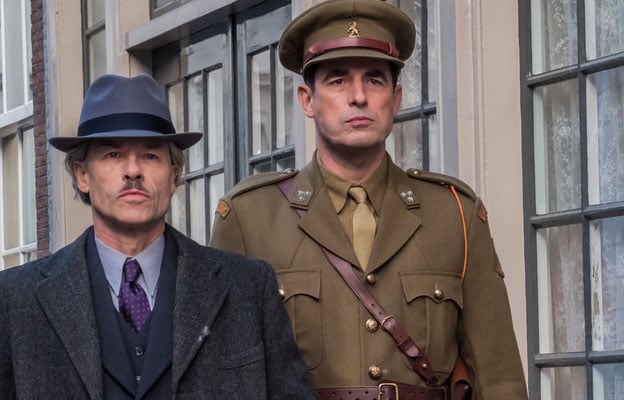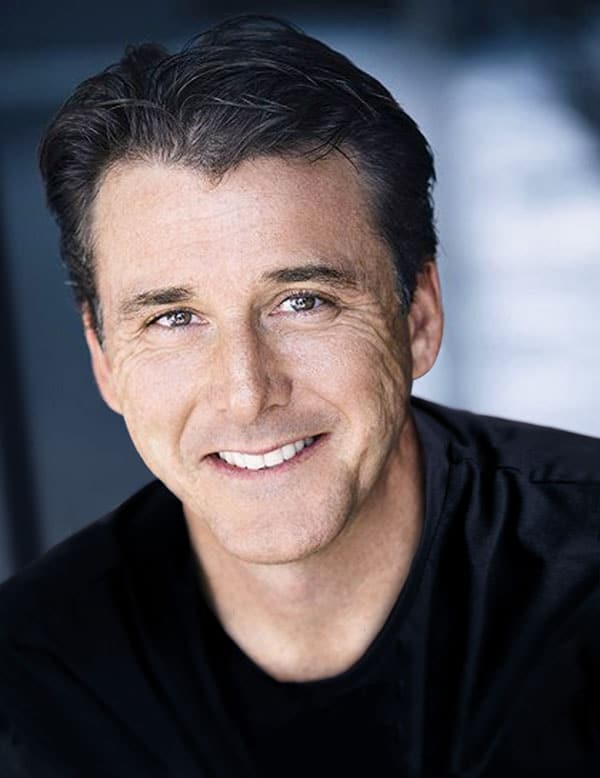 Roland Møller as Espen Vesser, Guy Pearce as Han Van Meegeren, Claes Bang as Joseph Piller in TriStar Pictures’ THE LAST VERMEER. Photo by Jack English.
Roland Møller as Espen Vesser, Guy Pearce as Han Van Meegeren, Claes Bang as Joseph Piller in TriStar Pictures’ THE LAST VERMEER. Photo by Jack English. Like the fact-based historical dramas “Woman in Gold” and “The Monuments Men,” about priceless art treasures stolen by the Nazis, “The Last Vermeer” has a similar motif, but tells a little-known and unexpected story of a Jewish war hero vs. a wily art forger (and possible collaborator) that takes twists and turns on the way to its courtroom conclusion. En route, it explores themes of morality, the value of art, and coping with the ravages of war.
Based on the book “The Man Who Made Vermeers” by Jonathan Lopez, the drama stars Claes Bang as Joseph Piller, a Dutch Jew and former Resistance fighter who is assigned to identify and recover art stolen by the Nazis. Guy Pearce plays his adversary Han van Meegeren, an eccentric art dealer suspected of selling priceless paintings to Hermann Goering and others, who faces the death penalty for collaboration. Piller initially seeks justice in the case, but evidence comes to light that makes him question everything.
Director Dan Friedkin first heard the story about six years before filming began in summer 2018, and was drawn to its themes involving World War II history, art and art history. “I’d assumed a film had been made about it, and when I found out there wasn’t [one], I knew it was a story that I needed to tell,” he said. He was also intrigued by the ideas of rebuilding a country post-war and the very nature of art: how we value it and what makes one piece of art more priceless than another.

“War brings out all these different things in people and everyone deals with it in their own way. Van Meegeren is a chameleon and morphed to deal with it and survive,” Friedkin said. “Piller thought if he brought men like van Meegeren to justice the world would be a better place. But where does that stop? At what point does he have to find peace from within? He has to find his own hope ultimately so he’s able to restore his faith and be the person that he is.”
Friedkin steeped himself in research about the period and the specific story, working closely with the writers, producers and actors before shooting began in Amsterdam and the Dutch countryside, and on additional locations in and around London and southern England. “There isn’t a lot that’s known about Joseph Piller, but what is known is that he served with the underground in liberating Jews and getting them out of the Netherlands at night. He’s an unheralded war hero.”
“There isn’t a lot that’s known about Joseph Piller, but what is known is that he served with the underground in liberating Jews and getting them out of the Netherlands at night. He’s an unheralded war hero.”
As a first-time director, “everything was daunting and challenging” for Friedkin, especially the climactic courtroom sequence, which he shot in chronological order over “several stressful days. We didn’t want to do a court scene that people have seen before. And If it didn’t work, it would have hurt the film,” he said.
Historical verisimilitude was important, but there were instances where dramatic license was taken, including the way the courtroom scene unfolded. “It’s more about getting people to understand and feel the film and the period than exact dates and historical references you’d find in a documentary,” Friedkin said. “You have an hour and a half to get the message across. You have to accelerate things. It’s the nature of making films.”
A film industry veteran who has executive produced Academy Award-nominated and Palme d’Or-winning “The Square,” Clint Eastwood’s “The Mule,” and Ridley Scott’s “All the Money in the World,” also Oscar-nominated, Friedkin “got the directing bug” while on set with Scott. “I spent a lot of time with Ridley and after that I couldn’t wait to try my hand at directing. I loved it and can’t wait to direct again,” he said. “I’ve been crazy about cameras since I was a kid. I love photography and have always been fascinated with how to frame and shoot things and how to make things look a certain way in post [production].”
Friedkin hasn’t lined up his next directorial project yet, but it’s likely to be based on another true story. Meanwhile, he’s continuing to produce films like Martin Scorsese’s “Killers of the Flower Moon,” starring Leonardo DiCaprio and Robert DeNiro. He described it as “a story about the birth of the FBI, an American western with a lot of history and Native Americans and oil, set in the 1920s.”
“The Last Vermeer” opens in several cities in Southern California including Thousand Oaks, Oxnard, Camarillo, Orange County, San Diego and Santa Barbara on Nov. 20, including the Vineland Drive-In in City of Industry. “I’m glad this will be a theatrical experience,” Friedkin said. “Hopefully, we’ll get a lot of people to see it.” For those unable or unwilling to do so due to COVID-19, a virtual release will follow.






















 More news and opinions than at a Shabbat dinner, right in your inbox.
More news and opinions than at a Shabbat dinner, right in your inbox.